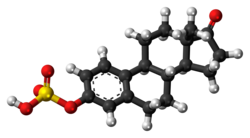 | |
 | |
| Clinical data | |
|---|---|
| Other names | E1S; Oestrone sulfate; Estrone 3-sulfate; Estra-1,3,5(10)-trien-17-one 3-sulfate |
| Routes of administration | By mouth, others[1][2][3] |
| Drug class | Estrogen; Estrogen ester |
| Pharmacokinetic data | |
| Protein binding | 90%, to albumin, and not to SHBG[4] |
| Metabolism | Desulfation (via STS)[6] |
| Metabolites | • Estrone[1] • Estradiol[1] |
| Elimination half-life | 12 hours[5] |
| Identifiers | |
| |
| CAS Number |
|
| PubChem CID | |
| IUPHAR/BPS | |
| DrugBank | |
| ChemSpider | |
| UNII | |
| ChEBI | |
| ChEMBL | |
| Chemical and physical data | |
| Formula | C18H22O5S |
| Molar mass | 350.43 g·mol−1 |
| 3D model (JSmol) | |
| |
| |
| (verify) | |
Estrone sulfate (E1S) is an estrogen medication and naturally occurring steroid hormone.[1] It is used in menopausal hormone therapy among other indications.[1][2] As the sodium salt (sodium estrone sulfate), it is the major estrogen component of conjugated estrogens (Premarin) and esterified estrogens (Estratab, Menest).[1][3] In addition, E1S is used on its own as the piperazine salt estropipate (piperazine estrone sulfate; Ogen).[1][3] The compound also occurs as a major and important metabolite of estradiol and estrone.[1] E1S is most commonly taken by mouth, but in the form of Premarin can also be taken by parenteral routes such as transdermal, vaginal, and injection.[1][2]
- ^ a b c d e f g h i Kuhl H (August 2005). "Pharmacology of estrogens and progestogens: influence of different routes of administration". Climacteric. 8 (Suppl 1): 3–63. doi:10.1080/13697130500148875. PMID 16112947. S2CID 24616324.
- ^ a b c "Drugs@FDA: FDA Approved Drug Products". United States Food and Drug Administration. Retrieved 19 February 2018.
- ^ a b c Brucker MC, King TL (8 September 2015). Pharmacology for Women's Health. Jones & Bartlett Publishers. pp. 361–. ISBN 978-1-284-05748-5.
- ^ Buchsbaum HJ (6 December 2012). The Menopause. Springer Science & Business Media. pp. 63–64. ISBN 978-1-4612-5525-3.
- ^ Wecker L, Watts S, Faingold C, Dunaway G, Crespo L (1 April 2009). Brody's Human Pharmacology. Elsevier Health Sciences. pp. 456–. ISBN 978-0-323-07575-6.
- ^ Cite error: The named reference
FalconeHurd2013was invoked but never defined (see the help page).
© MMXXIII Rich X Search. We shall prevail. All rights reserved. Rich X Search
